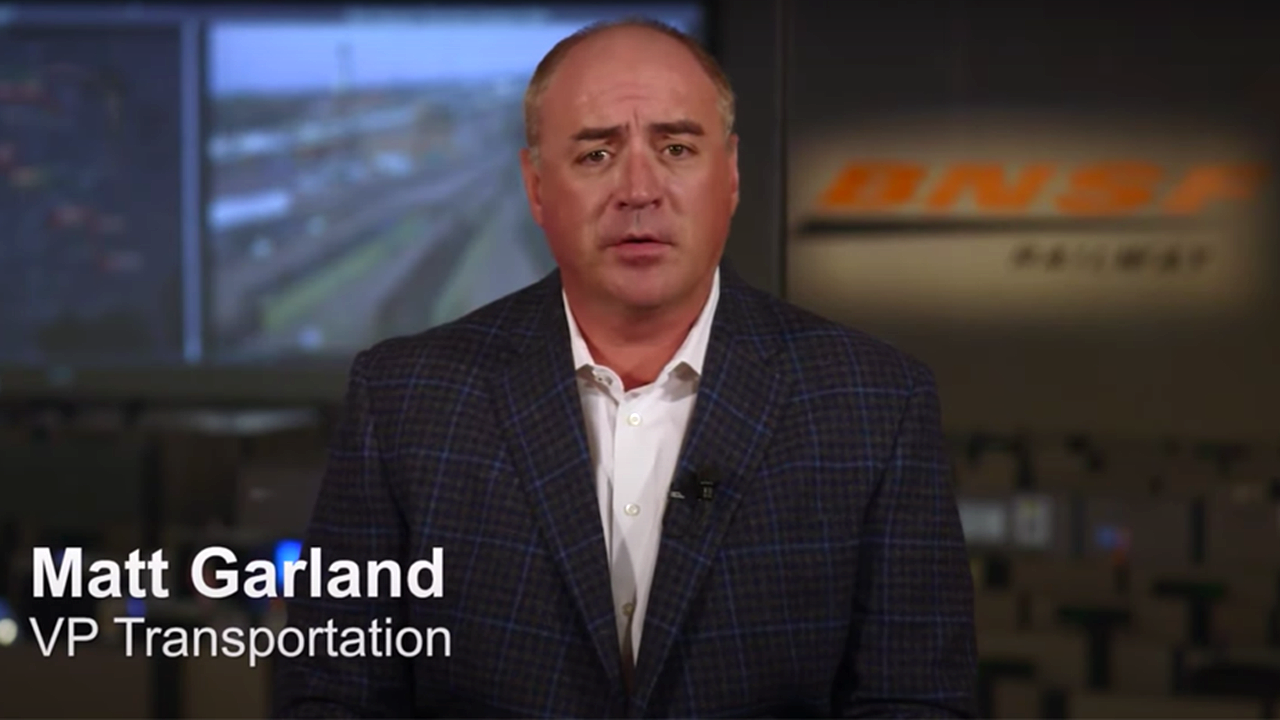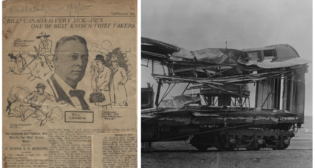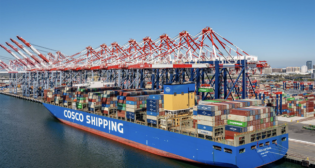
Q&A with BNSF VP Transportation Matthew Garland
Written by Rick Paterson, Managing Director, Loop Capital Markets
One by one, the U.S. railroads are getting their operating houses in order following the difficulties of 2022, and as that evolves we’re engaging with senior operations leaders to understand how they’ve engineered the turnaround, lessons learned, and how the future is going to be different from the past. We interviewed CSX on June 16, and now as BNSF has started putting up some good operating numbers, we’re pleased to share some Q&A with BNSF Vice President Transportation Matthew Garland, who has responsibility for all train operations.
Question 1: The BNSF Recovery Story

As an outside observer I’ve done my best to put words against the weekly BNSF operating data that we see from the STB, but we’d of course prefer to hear from you exactly how the BNSF operating team engineered the network’s recovery from the U.S. industry-wide service crisis last year. Your network fluidity seemed to bottom in April of 2022 while crew shortages peaked in July. Using that as a starting point, walk us through the last 12-months. What worked, didn’t work, successes and setbacks, how the network coped with winter, and what shape is the network in today?
Matt Garland: To answer this question, you really must go back to the beginning of 2022 for context. We had an extremely cold winter in the north and ongoing congestion at ports and inland terminals due to chassis shortages coupled with a shortage of warehouse workers. As our velocity deteriorated, rail cars on our network began to climb. We certainly understand why customers wanted to add more equipment, but it exacerbated the congestion. We were moving less volume with more resources. The growing congestion further constrained the resources we had available.
We knew we had to move quickly to regain service momentum, so we implemented a plan with aggressive measures to restore network velocity and bring our service product back up to our customers’ expectations. The plan had three primary drivers of network fluidity: locomotive availability, crew availability, and car inventory. The first two are really ensuring you have the right resources in place at the right time to move the freight that needs to move. We increased the active locomotive fleet starting with pulling more than 250 locomotives out of storage over the winter and added additional units throughout the spring. We increased the output from our locomotive shops by using overtime to repair locomotives faster. Both actions increased locomotive availability by turning the assets faster and resulting in improved fluidity as we moved toward late spring and early summer.
Crew availability was harder to tackle. As has been well-documented across all railroads, the recall success rate for furloughed workers did not match historic percentages when we called people back following the pandemic-driven volume drop in 2020. We mounted a hiring campaign that was considerably larger than our traditional hiring plan, which is matched to the volume we expect to move each year. But we achieved it and hired around 3,000 new employees in 2022, including about 1,800 additional TYE employees. Due to the competitive labor market all companies faced in 2022, we had to modify our hiring program in several ways to bring people on faster. In addition to incentives in hard to hire locations, we streamlined and reworked the application process to access a broader applicant pool. We also started training classes as soon as we could, rather than waiting for a larger class size to begin training. Of course, taking on a hiring plan of this magnitude during collective bargaining added an additional challenge. Fast forward to today, and I’m happy to report we have reached paid sick leave agreements with 11 of our 12 unions along with other scheduling changes that help improve the work/life balance of our employees’ schedules. We are more than sufficiently staffed to handle the forecasted volumes for the balance of the year.
The final piece of the service restoration plan to reduce cars online required frequent communication and collaboration with our customers. Managing active car inventory on the network is the single most impactful lever we possess to improve network fluidity and restore service consistency at critical terminals that our customers rely on. We know this is challenging for our customers, but it really was the quickest path to network recovery. A year later, and the railroad is in great shape with service at, or in some cases exceeding 2019 levels. Velocity continues to trend in the right direction, and we have solid momentum going into fall harvest and peak domestic and parcel seasons. BNSF’s hump yards have set all-time bests for productivity almost every month of 2023. Our people are aligned and pulling in the same direction. Through August, we have the lowest number of injuries in our company’s history and lead the industry in both injury frequency ratio and reportable equipment incidents. We credit our progress partially to our Transportation Safety Agreement that has been in place just over a year. This first-of-its-kind in the industry agreement with a portion of our transportation workforce has driven step-level improvement in our safety outcomes.
Our safety and service performance are also impacted by our capital program. As you know, our capital investment is $3.96 billion in 2023 for both maintenance and expansion. The largest component is for maintenance, and we’ll spend $2.85 billion this year alone keeping our railroad in the best condition it’s ever been. We also continue to increase capacity, and our capabilities, along the Southern Transcon with our multi-year double-tracking projects in Eastern Kansas and Southern California. Along our northern route, we recently completed the Sandpoint Bridge project, so we now have bi-directional traffic across Lake Pend Oreille which has been a chokepoint on our route to the PNW. The bridge, coupled with the double track work in Eastern Washington opens up significant capacity across the north. Additionally, we are excited to bring Montana Rail Link back into the BNSF network on January 1, 2024. This will provide even more capacity and drive additional efficiencies across our northern corridor.
Question 2: Crew Management

Railroads seem to get into trouble with crew capacity deficits—triggering meltdowns—at two points in the business cycle. The first and one we’ll focus on today is early in economic recoveries when the companies are coming out of a recession and recalling crews that were furloughed going into the recession. If the volume rebound is stronger/earlier than expected or the crew recall rate lower than expected, it’s game over. This, very broadly, explains the 2022 service crisis. In December last year, NS introduced a more conservative crew management strategy where furloughs in future will be substantially less, and surplus crews sent to training rooms to learn to be engineers until being redeployed back into the field. We thought this was an elegant solution that we hoped would promulgate through the industry. CN and CSX have also stated they’ve adopted a more restrained posture on furloughs that’s similar to the NS strategy. What, exactly, is BNSF’s strategy as it relates to conductor multiskilling and furloughs?
Matt Garland: As I mentioned, we brought on about 1,800 new transportation employees in 2022 and by year’s end, we’ll have added 1,200 more as we continue to hire in certain locations. With current volume levels, we are over resourced in some locations. However, we have chosen not to furlough this year to ensure that we are well-positioned to respond if markets begin to change quickly for our customers. For those locations that are over resourced we are pulling forward our Engineer Training Programs and working with our labor organizations to deploy temporary transfers across portions or our Ag network where we anticipate a robust harvest. We will again accelerate our engineer training for conductors through the first half of 2024. This 20-week program is designed to ensure our new engineers will possess the safety and operating practices skills necessary to perform the duties of a locomotive engineer and allows us to absorb any softness in the freight market and can quickly pivot if demand is higher than our current forecast. P
Question 3: Enhancing Resiliency

Given the spate of meltdowns within the industry in recent years we’ve all been painfully reminded that strong Class I rail service is a rare and valuable commodity. It’s easy to lose and when it’s gone it’s a long, hard, road to get it back. It’s also proven to be very difficult for any Class I to run consistently well for extended periods of time (multiple consecutive years for example) and external shocks from climate change is only going to make that more difficult. Given your network is now running well, what, specifically, is the operating team doing that is new or different from the past in order to entrench and institutionalize service resiliency so that the 2022 meltdown proves to be BNSF’s last meltdown? Put another way, what changes are being made that should give customers confidence that good BNSF service is here to stay?
Matt Garland: 2022 was hopefully a rare event that we don’t see again where every stakeholder in the supply chain faced challenges with staffing, wild swings in volume and two severe winters. I don’t like to be defensive about winter as we know it comes every year, but severe winters have a severe impact. Trains get shorter. It’s difficult to get crews to trains when a state’s entire highway network is shut down. You must be nimble and resourceful. For a brief period in North Dakota, we were the only mode of transportation continuously operating. I would say the largest impact that we’re facing is the increasing number of severe weather events in the past few years. At a macro level, extreme weather events have been on the rise, especially in the Western U.S. And not just winter weather either. Excessive heat, thunderstorm-caused high wind events and wildfires have all increased. We must be ready for that, adapt and not let it impact the operation. A good example of this recently was during Tropical Storm Hilary in Southern California, where the entire BNSF operations team resourced appropriately and enacted a solid plan to respond that significantly mitigated the impact and allowed for continuity of operations. We did extensive preparation for that event and mobilized equipment and put contractors on retainer ahead of the storm. It wasn’t an accident that we came out of it in good shape. We lost our southern Transcon multiple times and had a swift response to prevent major service disruptions. We are constantly evaluating weather threats, implementing plans, and then measuring our time to recover to continuously improve our response. We’re spending a lot of time on probabilistic weather forecasting and executing operational plans in advance. Completely different model than reacting to postevent. The downside is if the forecast is wrong it costs a little money, but looking at the probability of when an event will occur gives us more insight into making those decisions accurately to get ahead of events to enhance service recoverability.
To that end, we have been hardening the railroad in multiple locations to mitigate against disruption. We continue to improve our Winter Action Plan every year, and have deployed hundreds of additional switch heaters, increased the amount of locomotive winterization packages, and improved our pre-winter mechanical inspection processes of our car fleet. We are continuing to deploy fixed anemometers to more accurately measure wind increasing our ability to operate safely during wind events along with partnering with weather vendors to improve our understanding of when a severe weather event will occur. Hardening our network to ensure resiliency isn’t new for BNSF. Over the past few years, we have raised over 3,100 miles of track over 12’ in areas prone to flooding. For example, we recently raised our line segment in Northern California to prevent our tracks from being overtaken by water as Tulare Lake began to refill for the first time in 40 years. We have also raised the track across many portions of North Dakota that are prone to spring flooding. In addition to track lifting, we also invested significantly in slope armoring and stabilization to protect against future flooding events. We have also installed over 600 fuel cells to maintain signal operation during the power outages that often accompany significant weather.
Technology also plays a big role keeping our network fluid, specifically in the inspection arena. Technologies that you’re familiar with, like our Automated Track Inspection, or ATI program, using autonomous geometry cars. The geo cars improve the accuracy and reliability of track inspections and expand the footprint of what we’re able to inspect. Simply put, we can inspect more miles of track than before with fewer maintenance windows and deploy our maintenance crews more strategically and efficiently to target areas of need identified by the geometry cars. We now have the capacity to inspect more than 450,000 miles every year. In 2021 and 2022, we inspected about 425,000 miles each year and reduced our defect rates by 82% over the last five years and 8% year over year.
Question 4: Positioning the Intermodal Network for the Rebound

Customers are seeing good service from BNSF but they also see that the railroad’s volumes are soft. Year-to-date through Sept. 9, intermodal loads in particular are down 15% year-over-year in 2023. The sum of all other business is down 3%. Customers know that railroads run faster and better when volume pressure is off, and slower and worse when volume pressure comes back on. At some point that 15% intermodal deficit will correct— possibly rapidly—and it’s obviously critical that BNSF maintains an acceptable service floor as the pressure comes back on. What is BN’s strategy to prepare for and then maintain good intermodal service in the face of a double-digit rebound in volumes?
Matt Garland: It really comes down to executing well on three things:
- • Investing in our best-in-class facilities and infrastructure to support improved service reliability and meet the needs of our customers today and tomorrow.
- • Creating and deploying industry-leading, transformational technology.
- • Building with a future-facing mindset for the capacity our customers will need tomorrow.
These three items are really interdependent as certain actions like investing in our facilities or deploying technology also has a big impact on our service reliability. A good example is our Hobart intermodal facility in Los Angeles. Hobart is already the largest intermodal facility in North America with capacity for over 1 million lifts per year. While it’s not feasible to expand the footprint of the facility in the Southern California real estate market, we have to get creative to add additional capacity. In other words, we have to find ways to go up more efficiently with the limitation on expanding out. To that end, we have been exploring container stacking technologies across the network, including one called Pathfinder at Hobart that we developed in cooperation with Mi-Jack, one of our largest crane operators.
The Pathfinder essentially prepositions the work autonomously, be it a pick-up for a driver or a delivery to the crane operator to put it in the stack. So, this is about driver productivity as much as it is creating capacity in the stack. By eliminating the dependency on a crane operator for a driver to retrieve a container, it improves the productivity of each driver. We get more capacity out of our existing real estate while improving driver experience and productivity. Finally, there’s the third leg of building with a future-facing mindset. I previously mentioned the multi-year double and triple track projects in Kansas and California, specifically, our Emporia and Needles subdivisions. Both projects support growth and recoverability, but also supports service consistency now by helping us to better handle the day-of-week and seasonal swings in volumes.
Since 2019, we’ve added miles and miles of both main line tracks and intermodal crane production track capacity. In addition, we’ve added more than 6,000 parking spots of capacity at our intermodal facilities. We’re continuing this theme across our main tracks and endpoints to further improve transit performance, service consistency and overall capacity to say “yes” to bringing on our customers’ freight. We’ve also expanded our domestic intermodal footprint in the PNW with opening of the Tacoma South earlier this year. The new facility along with working with the Northwest Seaport Alliance to open the Terminal 5 on dock facility has significantly increased capacity and has sizable impact on network fluidity overall.
Last but certainly not least, we announced the Barstow International Gateway, or BIG, last fall, which is one of the most exciting intermodal infrastructure projects to be launched by BNSF in a generation. This $1.5 billion, state-of-the-art, master-planned rail facility in Southern California will be the first of its kind in the U.S. Once built, it will be the largest intermodal facility in North America, sitting on more than 4,500 acres, and will consist of a rail yard, intermodal facility, and warehouses for transloading freight from international to domestic containers. The facility will have multiple customer benefits, such as lowering supply chain costs and reducing carbon emissions. It also benefits our intermodal partners by reducing dwell at the Southern California ports and providing a lower cost rail move to an inland transload facility vs. the truck move today to existing facilities. Once containers reach Barstow, they will be processed at the facility using clean, energypowered handling equipment, and then loaded onto trains moving east. This combination of yard, intermodal facility and customer warehousing will allow us to offer new service lanes, more consistent and faster transit off the west coast ports and access to additional, scarce warehouse capacity in Southern California.
So, I go back to the beginning. If we execute those three areas well, (and I have every reason to believe we will because we already are), then our intermodal network is not only poised for the rebound but poised to succeed well into the future.
Question 5: Manifest Network On-Time Performance

I’ve enjoyed watching your service metrics improve over the past 12 months, but the one I’m still frustrated with and need to understand better is manifest on-time performance. I realize manifest is a smaller portion of your business, representing about 45% of average daily train starts versus 57% at UP, 53% at CSX, and 60% at NS, but 45% is still highly significant and the most recent on-time performance scores averaged 68% over the past four reported weeks (through 9/8). Technically, this means that three out of every 10 cars are a day or more late, which looks poor. Help us interpret this 68% number. Are there mitigating or contextual factors that make 68% acceptable, or is it genuinely unsatisfactory, and if that’s the case what’s being done to meaningfully improve it?
Matt Garland: We continuously strive to improve the experience for our customers. As mentioned earlier, we have had an intense focus on improving our merchandise service and our merchandise terminals are operating at peak levels of efficiency. Our first mile/last mile service is performing very well and is consistently now in the 90% range daily. I do think it’s important to note that a railroad’s merchandise network is very complex and each Class I reports schedule adherence very differently.
In Q2 of this year we launched a three-pronged strategic initiative to improve our Merchandise on-time performance. Merchandise operations are resource intensive, and now that our network has been reset, we have the crew and locomotive resources to provide consistent performance which starts with departing our manifest trains on time. Departing a train on time is a team sport and requires all departments (transportation, mechanical car and locomotive) to work together to achieve the desired result. Building the train and setting it on time provides the mechanical team time to complete a thorough and safe inspection, while making sure the locomotive consist is built ahead of departure and placed on the train and the crew is called—briefed and ready. All of these parts must be expertly choreographed to achieve the desired result of terminal On Time Performance.
The second tier of this strategy is to ensure we are making our scheduled connections to minimize car dwell and improve our inventory turnover rate. We measure this as percent of cars over dwell plan, and in the past 30 days we have seen a meaningful decrease which is not only improving our capacity, but also our customer transit consistency as more cars depart on time on the right train.
The final piece is to focus on quality train builds and not allowing for cars to depart out of route. It does no good to depart on time or decrease terminal dwell if a car is not moving on the right train to destination. The teams that are focused on merchandise performance are working within a framework of continuous improvement and if one terminal is underperforming, we have resourced a small team of experts that go on site to that terminal to assist and quickly get service turned around. This strategy is working. We have made incremental progress each day since this initiative was launched, and the entire BNSF team is committed to improving this aspect of our business and providing our customers the level of service they expect. PL
Question 6: To what degree is BNSF a Scheduled Railroad?

In terms of operational philosophy, there seems to be a spectrum of views on whether to, at one extreme, schedule as much of the traffic as possible to maximize network predictability, and at the other end of the spectrum hold trains—particularly bulk—to maximize for train length and tonnage and minimize train starts. Where exactly is BNSF on this issue? Has there been any shift in operational philosophy or strategy here in recent years?
Matt Garland: BNSF is where we’ve always been since we became a company in 1995. We have a bias for growth. Our business model has always been to grow, provide industry-leading service, receive appropriate value for what we do, and invest those returns back into the railroad to be positioned for further growth. We call it the virtuous cycle. Part of being focused on capturing growth is having a strong cost structure—getting everything you can out of your assets and driving efficiency. When you have a strong cost structure and drive value for the service you deliver, you usually have returns that justify reinvestment and the capacity to grow with your current customers while pursuing new growth opportunities. We have always relied on growth to be successful and will continue to do so into the future.
We focus on serving customers in a way that is economic and meets their needs. We don’t try to fit customers to our network by holding to a rigid schedule or holding trains to achieve some operational goal. We are customer-focused and match their needs with a service offering that works for both of us. That is essential to our long-term growth, particularly for customers who have a choice in their mode of transportation.



